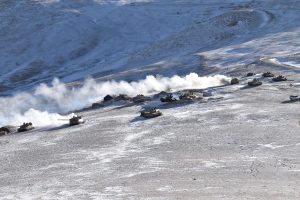
On this {photograph} supplied by the Indian Military, tanks pull again from the banks of Pangong Tso lake area, in Ladakh alongside the India-China border on Wednesday, Feb. 10, 2021.
Credit score: Indian Military through AP
India’s state of affairs alongside its disputed border with China in Ladakh seems to be way more critical than the federal government is letting on.
A police officer from Leh in Ladakh just lately disclosed that India has lost access to 26 of 65 patrolling points from the Karakoram Cross to Chumar alongside the Line of Precise Management (LAC) in Ladakh.
In her analysis paper submitted on the 57th annual convention of India’s prime police officers in New Delhi on January 20-22, Leh’s Senior Superintendent of Police P.D. Nithya stated that “due to restrictive or no patrolling” by Indian forces at a number of patrolling factors, India had misplaced entry to patrolling factors 5-17, 24-32, 37, 51, 52 and 62.
The absence of Indian troops at these patrolling factors opened up area for Chinese language troopers to maneuver in, the paper notes, forcing India to just accept that these areas now have a Chinese language presence. This has led to a shift within the LAC “towards the Indian side.”
It signifies that India has ceded territory beneath its management to the Chinese language.
Since April-Could 2020, when PLA troopers backed by tanks and armored personnel carriers crossed into areas that had been beforehand patrolled by the Indian Military, the state of affairs alongside the LAC has been tense.
The analysis paper argues that Indian apprehensions over drawing Chinese language ire, even objections to Indian presence in territory deemed disputed by Beijing has resulted in India adopting a “play safe” technique that has resulted in India pulling again from territory it managed beforehand.
That is opposite to what Indian political and navy leaders have been saying over the previous 2.5 years.
On June 19, 2020, 4 days after Indian and Chinese language troopers clashed at Galwan Valley, Prime Minister Narendra Modi denied outright that Chinese language troopers had crossed into the Indian aspect of the LAC. “Neither has anyone intruded into Indian territory nor has anyone captured any military posts,” he acknowledged emphatically. Ministers and navy officers have since echoed him and claimed that India has “not lost even one inch of territory” lately.
Moreover, the Modi authorities has typically sought to challenge a tricky, uncompromising stance in the direction of the Chinese language on the border query. Protection Minister Rajnath Singh has typically stated that India would give a “fitting reply” if “even an inch of our land” was taken.
Nevertheless, the fact on the bottom alongside the LAC has been fairly totally different, as per the analysis paper.
Not solely has the Indian Military been pulling again from areas it historically patrolled but in addition it has performed protected by putting “much restrictions on the movement of civilians and grazers near the forward areas on the Indian side” to keep away from annoying the Chinese language or giving them “the chance to raise objections” to Indian exercise or presence in “areas claimed as disputed,” the paper notes.
Removed from giving a “fitting reply” to the PLA’s advance into Indian-controlled territory, India’s response has been timid.
“The government’s official narrative stands exposed,” factors out Lt Gen (retd.) Prakash Katoch.
The paper recollects that senior civilian officers of the district administration in addition to the safety forces used to “easily patrol” as much as the Karakoram Cross, which is 35 km from India’s northernmost publish at Daulat Beg Oldie (DBO). Nevertheless, this modified in December 2021, when the Indian Military arrange “restrictions in the form of check posts” at DBO “to stop any such movement towards Karakoram Pass,” because the PLA would object to any “movement [towards Karakoram] from the Indian side if not informed beforehand.” These areas then turned “informal buffer zone,” to which India has misplaced entry.
The territorial good points that the PLA made on the bottom by way of its salami slicing technique had been taken ahead by its navy commanders at negotiations with their Indian counterparts. The talks led to disengagement of troops from some friction factors it has come at a heavy price as India needed to comply with buffer zones. These buffer zones had been created as per the brand new modified state of affairs on the bottom relatively than the pre-April 2020 floor state of affairs. Consequently, the no-patrolling areas have come up largely on territory on the Indian side.
A lot of what the analysis paper says has been stated earlier than.
A December 2020 report in The Hindu stated that a minimum of 30 patrolling points in Ladakh weren’t being patrolled any extra by Indian troopers. A piece of former military officers and safety analysts have been drawing consideration to India’s territorial losses within the Himalayas. They’ve identified that disengagement from 4 friction areas “have been disadvantageous to India” as buffer zones have come up both “entirely on territory both claimed and previously patrolled by India but now, as a result, India is denied the right to patrol up to where it previously could.”
The paper affirms what specialists have been saying for two.5 years – India is dropping territory to the Chinese language.
{That a} police officer based mostly in Ladakh has verify these apprehensions is critical.
The query is whether or not Nithya’s paper and the storm it has kicked up will nudge the Modi authorities to take parliament into confidence on the matter. Or will obfuscation and denial proceed to be the federal government’s response?
Quickly after the analysis paper was printed in a number of Indian newspapers, India’s Ministry of House Affairs took down the paper from its web site.
That could be a pointer to the federal government’s technique going forward.
#asiannews #asian_news
